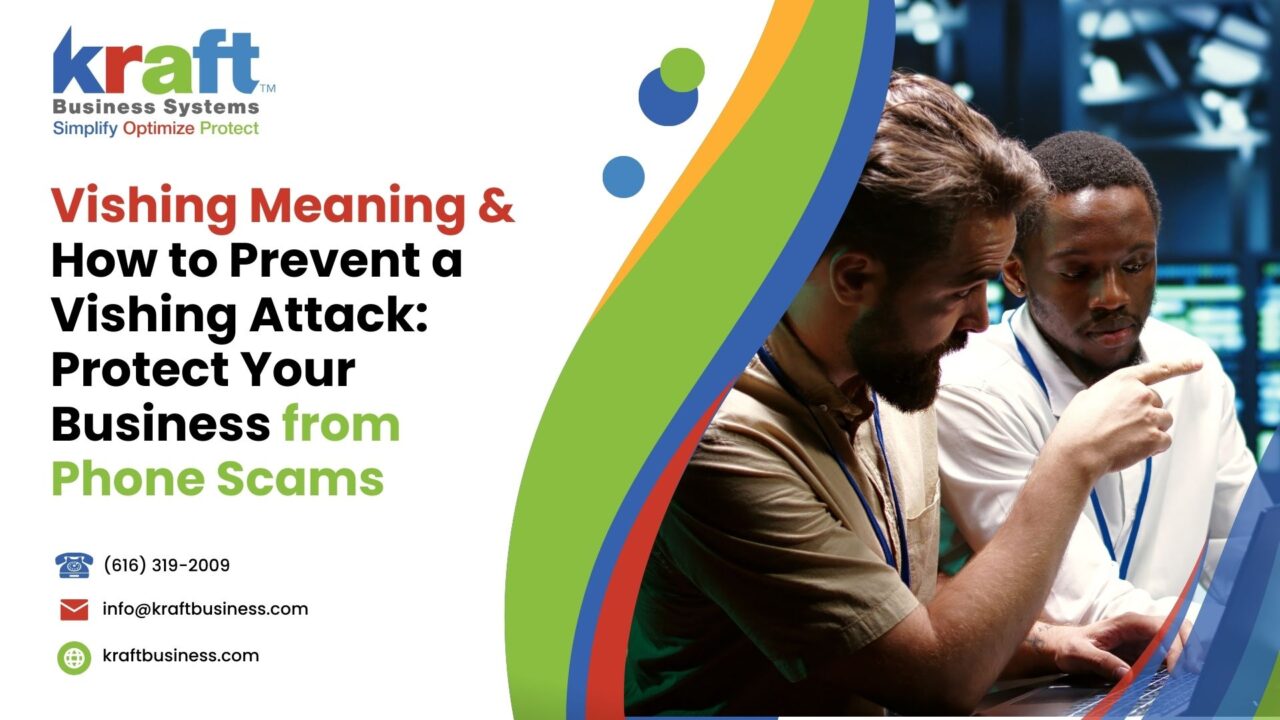Vishing Meaning & Attack
The evolution of cyber threats has brought new challenges to businesses and individuals alike, with vishing being one of the most prevalent and dangerous scams in the realm of cybersecurity. Vishing, a portmanteau of “voice” and “phishing,” involves attackers using phone calls to deceive victims into divulging sensitive information.
The goal of these vishing scams is typically to gain access to financial information, personal details, or even secure credentials that can be exploited for identity theft or further phishing attacks. Understanding how vishing works and how to protect your business from it is crucial in today’s digital landscape, where social engineering techniques continue to evolve and pose serious threats.
Common Vishing Scams Meaning Targeting Businesses and Individuals
Vishing scams can take various forms, each tailored to exploit specific weaknesses in the victim’s security posture. One of the most common vishing scams is the IRS scam, where the caller pretends to be an IRS agent, threatening the victim with immediate legal action unless they provide payment details. Another widespread tactic is the technical support scam, in which the caller claims to be from a reputable tech company, warning the victim about malware on their device and requesting remote access.
Additionally, social security administration scams often target elderly individuals, using fear and urgency to trick them into sharing their social security numbers or other personal information. These types of vishing attacks are particularly dangerous because they exploit the lack of familiarity with digital threats among certain demographics.
Smishing and Vishing: Understanding the Connection
Smishing, or SMS phishing, is a closely related form of social engineering attack that uses text messages to deceive victims. Smishing attempts may involve sending a text that appears to come from a legitimate source, such as a bank, instructing the recipient to call a specific number. When the victim calls, they are connected to a vishing scammer who follows the same process used in voice-based phishing attacks.
Both smishing and vishing rely on creating a sense of urgency and exploiting human trust. However, smishing can sometimes be even more effective because people tend to trust text messages more than emails or calls. The combination of smishing and vishing attacks can significantly increase the likelihood of a successful scam, making it essential to recognize the signs of these threats.
What is a Vishing Attack? Understanding the Definition and Signs of Vishing
Vishing, also known as voice phishing, is a type of phishing attack that uses voice calls rather than emails to trick individuals into revealing sensitive information. Vishing attackers often pose as legitimate organizations, such as banks, government agencies, or technical support teams, to gain the trust of their targets. These scams are carefully executed, making it difficult for victims to recognize vishing attempts without proper awareness and security measures.
The primary sign of vishing is the creation of a sense of urgency, using social engineering tactics to manipulate the victim into taking immediate action. By pressuring the recipient, vishing attackers aim to extract personal information such as credit card numbers, account details, or even Social Security numbers. Spoofed phone numbers are often used, making it appear as if the calls are coming from trusted sources, complicating the identification of vishing attacks. Common examples of vishing include fake tech support calls, IRS scams, and fraudulent bank requests, making it essential for businesses to understand the definition of vishing and stay vigilant.
How Does a Vishing Call Work? Identifying and Responding to Vishing Attacks
Vishing calls typically follow a structured process where the attacker crafts a scenario to compel the victim into acting quickly. The vishing caller usually starts by identifying themselves as a trusted source, like a bank representative or a member of the Social Security Administration, creating a false sense of security. They may reference some personal information already available to them, which is a common sign of a vishing attempt, giving the impression that the call is legitimate.
Once the victim is convinced, the scammer introduces a problem—such as suspicious account activity—and requests verification of sensitive details. This is a typical example of vishing, where voice phishing techniques are used to deceive the target. Automated vishing calls, often referred to as robocalls, can reach a large number of people quickly using Voice over Internet Protocol (VoIP) systems. These robocalls may prompt victims to call back, connecting them directly to a human scammer who will proceed to extract more information. To recover from a vishing attack, businesses should report the incident immediately, secure compromised accounts, and educate employees on how to recognize vishing threats in the future.
Vishing vs Phishing: Key Differences and Common Examples of Vishing
Phishing and vishing are both forms of social engineering attacks aimed at stealing sensitive information, but they differ significantly in their approach and execution. While vishing uses voice calls to manipulate victims, phishing primarily relies on fraudulent emails that mimic legitimate communications. Phishing emails often contain malicious links or attachments, which make them easier to identify, whereas vishing attacks are more reliant on verbal persuasion over the phone.
The main difference between vishing and phishing is the medium used—phone calls versus emails. However, the intention remains the same: deceive the victim into divulging personal and financial information. A common example of vishing would be a caller pretending to be a bank representative asking for account verification. In contrast, phishing might involve an email directing the recipient to click on a link to update their credentials. To identify a vishing attack, it’s essential to watch for signs of vishing such as unsolicited calls, high-pressure tactics, and requests for private details. Being able to recognize vishing attempts will help prevent falling victim to these scams and safeguard your sensitive information.
Recognizing the Signs of a Vishing Attempt
Vishing calls often include tell-tale signs that can help in identifying them before any damage is done. A common sign of a vishing attempt is the manipulation of caller ID to display a legitimate number. Scammers may use this tactic to make it appear as if the call is coming from a trusted source, such as a bank or government agency.
Another indicator is the use of a sense of urgency. Vishing attackers will often create scenarios that require immediate action, like confirming a recent transaction or addressing fraudulent activity. Additionally, if the caller requests sensitive information, such as a credit card number or Social Security number, without proper verification, it is a strong indicator of a vishing attempt.
Employee Training: Security Awareness and Best Practices
Training employees to recognize vishing and other social engineering attacks is one of the most effective ways to prevent vishing scams. Security awareness training should focus on educating employees about the different types of vishing attacks, including how vishing uses voice to manipulate victims and how to identify vishing red flags.
Role-playing and simulation exercises are excellent tools for teaching employees how to respond to vishing calls. These exercises can mimic real vishing scenarios, helping employees practice identifying and reporting suspicious calls. Implementing such training programs will build a culture of security awareness within the organization, reducing the chances of falling victim to a vishing attack.
Technical Solutions to Prevent Vishing Attacks
In addition to training, businesses should implement technical solutions to minimize the risk of vishing attacks. Caller authentication systems can help verify the legitimacy of incoming calls, while VoIP security features can prevent spoofed calls from reaching employees. Additionally, call-blocking software can be used to filter out known vishing numbers.
These technical measures, combined with robust security policies, can significantly reduce the chances of a successful vishing attempt. However, it’s important to remember that no technology can replace the human element of security. Continuous monitoring and updates to security systems are essential to staying ahead of evolving vishing tactics.
Protecting Sensitive Information: Best Practices for Businesses
Protecting sensitive information should be a top priority for businesses of all sizes. Establishing strict policies around sharing personal and financial data can prevent employees from inadvertently divulging sensitive information. For example, businesses should enforce a policy that requires employees to verify the caller’s identity through independent means before sharing any details.
Furthermore, employees should be trained to never provide sensitive information over the phone unless they are absolutely certain of the caller’s identity. Implementing these best practices will safeguard both personal and business information from falling into the hands of vishing scammers.
Steps to Take After Experiencing a Vishing Attack
If your business has been targeted by a vishing attack, immediate action is required to minimize the impact. The first step is to report the incident to the relevant authorities, such as the Federal Trade Commission (FTC) or local law enforcement. Then, review all accounts and sensitive data to identify any compromised information.
Next, notify all affected parties, including employees and clients, about the incident and provide guidance on what steps to take. Changing passwords, implementing multi-factor authentication, and conducting a thorough security audit are crucial steps to secure your business after a vishing attack.
Guide to Preventing Vishing Scams in Your Business
A strong defense against vishing scams requires a multi-layered approach, as vishing is a common form of phishing that continues to evolve. Start by conducting regular security checks and updating your cybersecurity policies to identify any attack vector that may indicate a vishing attempt. Implement security awareness training to educate employees on vishing techniques, how phishing attackers operate, and ways to identify phishing attempts. This form of phishing often uses social engineering tactics, making it critical for employees to recognize vishing indicators like urgent requests for personal information.
Deploy modern phishing solutions and AI-based threat detection systems to monitor unusual call patterns, which are often a sign of a cyber attack. Since phishing and vishing scams are becoming more sophisticated, using advanced technologies can help detect even subtle vishing techniques. Staying proactive, reviewing policies regularly, and educating staff on recognizing vishing and other phishing schemes are essential steps to protect your business from these growing threats.
FAQs
What is the definition of vishing, and how does it relate to phishing?
The definition of vishing, or voice phishing, involves using phone calls to trick victims into sharing sensitive information. Vishing is a type of phishing attack that targets victims through voice calls instead of emails. The main difference between phishing and vishing is that phishing occurs via email, while vishing takes place over the phone. Both vishing and phishing are social engineering methods that manipulate individuals by pretending to be from trusted sources.
What are the common signs of vishing?
Common signs of a vishing attack include unfamiliar caller IDs, unexpected requests for personal details, and urgent language designed to create panic. Vishing attacks often create a false sense of urgency to pressure victims into revealing sensitive information quickly, making it critical to stay calm and verify the caller’s identity independently.
How can I recognize vishing and differentiate it from phishing?
To recognize vishing attacks, look out for vishing schemes involving unsolicited calls that use manipulative tactics. Phishing attacks typically involve fraudulent emails with malicious links. A guide on phishing can help distinguish between the two, but the key difference between phishing and vishing lies in the communication channel: phishing uses emails, while vishing uses voice phishing.
What are some common examples of vishing attacks?
Common vishing examples include tech support scams, IRS phone frauds, and fake bank calls asking for account details. These successful vishing attacks rely on impersonation and urgency, often using phrases like “your account has been compromised” to provoke a reaction. Vishing schemes target both businesses and individuals, making many vishing attempts hard to detect.
How do I identify a vishing attack and respond safely?
To identify a vishing attack in progress, check for the signs of a vishing attack such as an unknown caller asking for sensitive details or urging immediate action. Avoid sharing information, end the call if it feels suspicious, and report it to your organization’s cybersecurity team to prevent future vishing schemes.
What should I do to recover from a vishing attack?
To recover, immediately change any compromised passwords, monitor financial accounts for unusual activity, and inform relevant authorities. This helps limit the impact of vishing and ensures prompt action is taken.
How can businesses prevent vishing and phishing attacks?
Businesses can prevent vishing and phishing attacks by educating employees on how to recognize vishing schemes, using caller authentication tools, and employing strong security policies. Since vishing is also a form of phishing that uses voice, implementing robust anti-phishing measures across all communication channels is essential.










